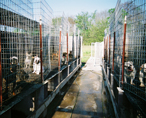 issue |
issue > puppy/kitten mills > pet trade industry
KEY MESSAGE: In the United States, the pet trade industry generates billions of dollars due to a sophisticated distribution system, profiting many players. Breeders and dealers are a subset of this industry, producing and providing the "living products."
A multi-billion dollar industry By 2030, it's estimated the pet trade industry will be a $275 billion dollar industry. As with other industries, it depends on a full system of distribution that crosses state borders, which is why it’s defined in terms of commerce. Breeders are only one part of the ‘commerce’ picture.
Photo of dog in cage at dog auction, waiting to be sold. Some Minnesota dog breeders sell their "unwanted" dogs at auctions. Two main dog auctions are in Missouri.
A growing industry • Per American Pet Products Association 2023-2024, 86.9 million US households own a pet, which accounts for 66% compared to 62% in 2022 and 56% in 1988. - posted on Animal World Foundation • Every year, "over 6.5 million dogs and cats, and other household pets are surrendered to animal shelters. Sadly just over 4 million find a home every year, leaving an ever-increasing number of animals in the shelter population." - World Animal Foundation • 690,000 shelter animals were euthanized in 2023. - World Animal Foundation • The U.S. Census states that about 33% of Americans have kids (under 18 years of age) living at home. In other words, more homes have pets than kids. It’s estimated that 65.1 million households own a dog and 46.5 million households own a cat in the United States (per APPA - American Pet Products Association). *Source: World Animal Foundation
Other pet ownership facts:
Americans love their pets. When the public buys, however, they’re often not aware of how and where these animals are being ‘produced’. |
 |
"));